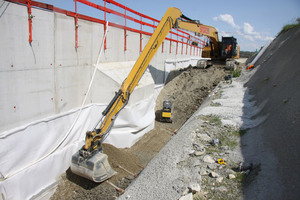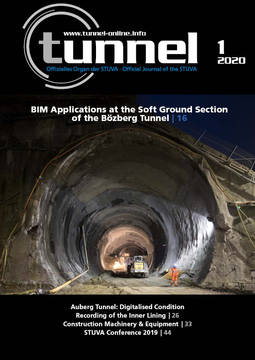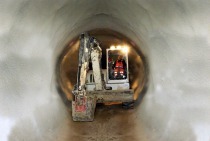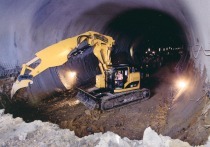Waggershauser Tunnel: Crawler Excavator with Great Reach
The B31 is one of the main roads with the heaviest traffic in the administrative district of Tübingen, Baden-Württemberg (Germany). The 7 km long section between Immenstaad and Friedrichshafen should be completed by the end of 2020 and will then relieve traffic congestion in the region of Lake Constance. Near Waggershausen, a 700 m long tunnel will provide noise protection. The structure consists of two tubes each with two lanes in one direction.
While the company Baresel from Leinfelden-Echterdingen is responsible for tunneling in the joint venture, Storz from Tuttlingen is responsible for earthworks, with a new Cat crawler excavator 326F SLR taking a key role in their machine park consisting of up to a hundred wheeled and crawler excavators.
Its main feature is the extra-long boom, with a reach of 18 m and a depth of 14.7 m. The excavator with a weight of a good 30 tonnes has a 10 m long boom and 7.85 m long dipper arm. It needs this reach when it cannot approach directly, as at the Waggershauser Tunnel.
790 mm wide grouser shoes were selected for the tracks of the excavator, and the counterweight was increased to 6.7 tonnes. This distributes the 30 tonnes self weight of the machine well. Nonetheless, handling the machine is different from the standard version, demanding a skilled driver.
Like Alexander Jennewein. He has to control the long boom with fingertip feeling, especially on the Waggershausen tunnel site when he is working directly on the trough structure in the 4.5 m wide trench, and the back of the bucket is only a few centimetres from the structure.
With the Cat 326F SLR, the driver must look after backfilling to the top of the structure. The new long-arm excavator has to be carefully driven for another reason: evaluation of aerial photos from the Second World War showed that munitions could be present on the site, and a particular hazard is a concentration of bomb entry funnels and thus suspected unexploded bombs in the area of the tunnel. The excavator has hydraulics for hammer and shears and has a quick coupler OQ 65 to change between loading and deep buckets. An encapsulated GPS box with sensor is integrated into the back of the bucket in order to be able to follow the precise position of the tools. The crawler excavator also has a machine control – the company has been using 3D control systems for 15 years now and uses the data for work preparation as well as for calculation purposes.
The works to be carried out by Storz on the tunnel site include 300 000 m³ of excavation, 156 000 m³ of embankment filling and 140 000 m³ of backfilling to the structure.




